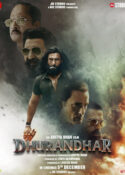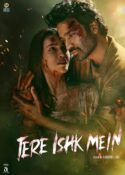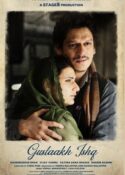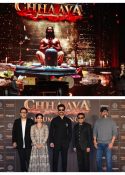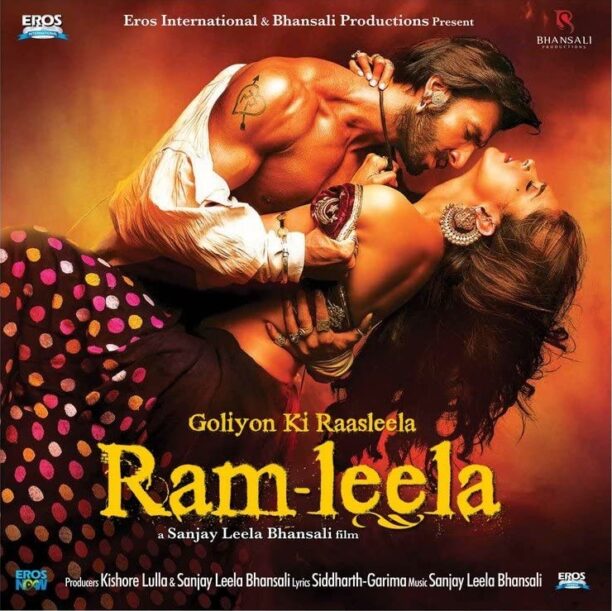 Goliyon Ki Raasleela Ram-Leela is Sanjay Leela Bhansali’s most violent film to date. It is also his raunchiest and sexiest film to date. Adapting Shakespeare’s Romeo and Juliet to a Gujarati milieu was a child’s play for Bhansali. But his Gujju Romeo and Juliet were so trigger-happy in so many ways that the film became a swirl of scintillating celebrations.
Goliyon Ki Raasleela Ram-Leela is Sanjay Leela Bhansali’s most violent film to date. It is also his raunchiest and sexiest film to date. Adapting Shakespeare’s Romeo and Juliet to a Gujarati milieu was a child’s play for Bhansali. But his Gujju Romeo and Juliet were so trigger-happy in so many ways that the film became a swirl of scintillating celebrations.
In terms of its free-flowing unmeasured operatic opulence Ram-Leela (with or without the censorial pre-fix) comes closest to the giddy high-pitched and yet miraculously controlled tempo and tenor of Bhansali’s Devdas. That too was a steeply sensuous cinematic adaptation from a literary source. Ram Leela goes to Shakespeare’s Romeo and Juliet and comes away with a marvel of a tale of love-at-first-sight. Bhansali tilts his hat to mythology, folklore and the culture of community clashes with a blend of spontaneity and brilliance that comes naturally to only this filmmaker, and no one else. Bhansali’s visuals remain as stunning and poetic as they were when he made his directorial debut.
What he does to Shakespeare’s tumultuous saga of sudden love between scions of two warring families is beyond the imagination of all other living filmmakers of this country. The rigorous reworking of the Shakespearean classic required a certain sense of recklessness. During the same year as Ram-Leela we saw some of the same creative recklessness in two other Bollywood adaptations of Romeo and Juliet, namely Aanand Rai’s Raanjhanaa and Manish Tiwary’s Issaq.
But Bhansali is Bhansali…Every image, every frame tells a story. Every shot in this brilliant film has a place in his cosmos. You weren’t left wondering for even a split second why you saw what you just did. It’s all a part of a grand design. And yet so overflowing with an unrehearsed warmth and vivacity, so brimming with spontaneous joie de vivre, and celebration, you wonder if Shakespeare’s play was written for this day when Bhansali’s deconstruction of the material would give to us characters who are many many sizes larger than life.
Yup, size matters. And in the case of Ram-Leela you can say that with a wink. Bhansali’s Romeo and Juliet, played with by Ranveer Singh and Deepika Padukone who actually fell in love during shooting, are unabashedly sexual in the body and verbal language. None of that traditional coyness and hesitation that characterizes traditional courtship when Ram and Leela discuss one another’s vital statistics. He runs a porn video parlour. She comes from a family of gun-wielding criminals helmed by a steely matriarch (Supriya Pathak, brilliant). He comments on her ‘136 inch’ chest, she talks about his, er, trigger. They are in love and they know lust is an integral component of their relationship.
No two lovers derived from a classic romance have celebrated their mutual sexual desires so frankly and fearlessly. Gosh, these two are Romeo and Juliet on steroids! And this is as good a place as any to tell you that no other two actors could have done to Bhansali’s Romeo/Ram and Juliet-Leela what Ranveer and Deepika have done. They don’t play the two characters. The couple owns their characters. From the moment he spots her at a Holi bash, unholy thoughts begin to cross randy Ram’s mind.
Ranveer plays Ram as a libidinous son-of-a-gun….and you can take that literally since there are more gun’s in Bhansali’s colourful Gujarati town than there were in Anurag Kashyap’s Wasseypur.
As for Deepika Padukone…if Shakespeare was alive (and in many ways this film does bring him back to life) he would have penned a full-blooded sonnet on Deepika’s beauty and grace. When she expresses anger she is molten lava and when she dances she is the epitome of feline grace. If 2013 is the year of the bewilderingly beautiful Padukone then Ram-Leela is her piece de resistance, and one that impels a standing ovation for the actress and her director. Yup, she can show this one to her grandchildren with pride of ownership.
So much has been said about Bhansali’s visual sense. But not enough. The way he composes the shots to convey the passionate desperation of lovers who know they’re running out of time is a subject that textbooks can be written about. With a magician’s dexterity Bhansali weaves the characters into frames with seamless splendour magically making space for the passionate and the tender.
In his quest for the most visually invigorating shots the director is here assisted amply by his cinematographer Ravi Varman. Varman, let me state, uses the camera like Ustad Amjad Ali Khan uses the Sarod. It’s an instrument to converse with divinity. Wasiq Khan’s art work too unfurls a spiraling tapestry of kaleidoscopic colours that find a place in the hectic frames without jostling or crowding the canvas.
Of the innumerable imperishable images that emerge from Ram-Leela’s tumultuous tale of overnight passion, elopement, estrangement and reunion, I’d single out two. The first shows Barkha Bisht as Ranveer’s widowed sister-in-law running away from a gang of attackers. As she runs through the rugged hinterland her brass vessel tumbles down-slope with her. The sequence, caught in a desperately dying light, is probably the most vivid image of impending doom I’ve seen in any film in the past two decades.
The other unforgettable image features Deepika, her hand bloodied after an injury, lying on the wet ground in a streak of blood. It reminded me of Aishwarya Rai’s slashed wrist creating a pond of blood with her hand in Bhansali’s Hum…Dil De Chuke Sanam.
Fire and blood are never far away from Bhansali’s vision. Though there are plenty of bloodied images in Ram-Leela, the fire this time rages in the eyes of the characters. Ram Leela’s visual poetry is so eloquent you wonder at times if the filmmaker is a closet-painter. A closet-musician, Bhansali certainly is. His self-composed songs assisted by Monty Sharma’s evocative background score perfectly capture the film’s impetuous mood.
The actors do the rest. Every performer surrenders to the tempestuous saga. While Supriya Pathak leads the supporting cast with a stellar performance, Richa Chadha, Abhimanyu Singh, Gulshan Devaiah and Sharad Kelkar are the portrait of pitch-perfect emoting.
Exhilarating, tumultuous, passionate, flamboyant, fluent and quite simply fabulous….Sanjay Bhansali’s Gujju take on Romeo and Juliet would have surely made Shakespeare giddy with joy. Brimming with exuberance and energy Ram Leela’s exalted aesthetics and powerhouse narration once again prove Bhansali to be an incomparable storyteller. As for the Ranveer-Deepika pair, their frankly erotic pairing is comparable with Raj Kapoor and Nargis in Awara.
Goliyon Ki Raasleela Ram-Leela which turned 12 on November 15 was Sanjay Leela Bhansali’s toughest film.
Recalls SLB , “I agonized over every single frame . Until the last minute I kept working on it. They had to literally drag me away from the editing.”
While many aspects of the film caught people’s attention it is the aggression and the action that were the talking point.
Says SLB, “Before Ram-Leela there was nothing more than a slap in my films. In fact, action director Shyam Kaushal would complain in every film, ‘Why call me for action direction for just a slap?’. This time in Ram-Leela we had enough action to make Shyam Kaushal Happy.”
Guns which form an integral part of the violent love story have never been seen in a Sanjay Leela Bhansali film before.The film’s title is preceded by a subtitle which reads ‘Goliyon Ki Raas Leela’
That just about says it all.
To convey the sexual attraction between Ranveer and Deepika, Bhansali just had to explain to them what he wanted. “They had never played such unabashed characters. Once in a while Deepika would get taken aback by her character’s uninhibited behaviour. But she would convey exactly what I wanted. Both of them are marvelous actors. They made the expression of love so effortless and magical. They have conveyed the purest form of love.”
And yet lovers Deepika Padukone and Ranveer Singh don’t really sleep together in the film.
Says Bhansali, “That’s the irony, which took me away from the original Shakespearean play. For me, it was important to show that the lovers could only be united completely in death. I wanted to hold back the consummation of their love.
Says SLB, “It was a bright happy colourful film. I returned to my Hum…Dil De Chuke Sanam and Devdas style of filmmaking.Ram-Leela came after the failure of two of my films.We had worked with equal passion on Saawariya and Guzaarish. Both the films are as precious to me as Ram-Leela. But somehow our efforts did not connect with the audience. That broke my heart. I got back to direction determined to get back my audience. I needed Ram-Leela to reach out to the the widest possible audience. Not that I made Ram-Leela to prove anything. I made the film I enjoyed making and I hoped audiences would share my pleasure.”


